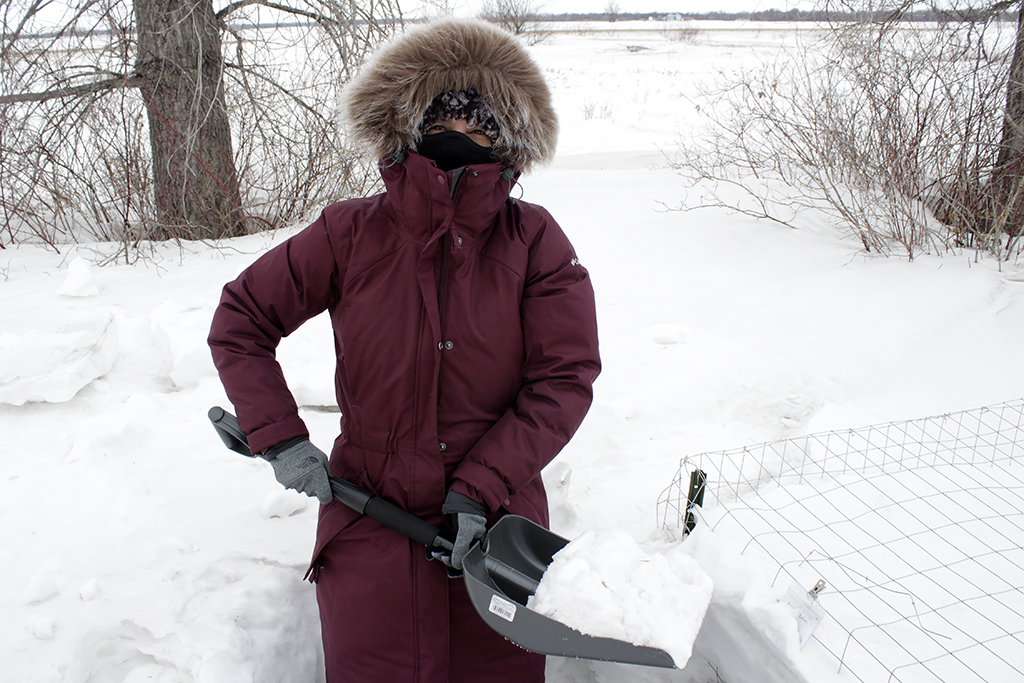A little fly told her
At crime scenes, tiny creatures such as flies can leave giant clues. And a UND forensic scientist is exploring how that works in subzero cold

Lucilia sericata.
She wears an iridescent coat of inkjet green as she symbolically stands guard on a sign posted outside Lavinia Iancu’s high-tech laboratory.
True to her purpose, the winged wonder signifies both life and death. And to forensic entomologists such as Iancu, she’s not only pretty important but also just plain pretty.
“To most people, they’re just a picnic pest,” said the director of the Forensic Science Department at UND’s College of Arts & Sciences. “But if you’re looking at them under a stereomicroscope, I’m going to tell you that they’re very beautiful.”
Lucilia sericata?
That’s right. She’s talking about a fly.
It’s probably safe to say not too many people can appreciate the insect’s beauty in the same way. Nor do many likely know the common green bottle fly — or blowfly — prefers the heat, and the metallic blue fly, the cold.
Even fewer likely know that the flies can smell decaying flesh 8 to 10 miles away and migrate fast enough to reach the body within a few hours.
They feed. They lay eggs. And they fascinate.
That’s because when it comes to a suspicious or unattended death, they can leave behind important clues.
Depending on the surrounding temperature and environment, different species of insects will colonize a decomposing body and cycle through predictable and time-certain life stages, Iancu explained. It’s those stages that can tell forensic investigators and scientists not only how long the person has been deceased but also whether the body may have been moved after death or if toxins are present.
In a way, Lucilia sericata is the proverbial fly on the wall — or, witness to murder.
Getting the bug
The Romanian-born Iancu says she first had planned to pursue a life in medicine but changed course when she got hooked on forensic entomology research while working at the Grigore Antipa National Museum of Natural History in Bucharest. At the same time, she earned master’s degrees in medical biology and forensic science.
“I think (the museum) was the place where my passion for forensic entomology really started. It was a place filled with scientists, and it was just a really wonderful place for me to expand my knowledge and collaboration,” Iancu said. “I always wanted to teach, to research and work with students. I don’t know everything, but what I do know I like to share, and I really feel the need to raise awareness about forensic entomology.”

The crime rate in her native country is very low, she explained, so forensic entomology is not commonly used in criminal investigations like it is in the United States and other countries.
“I can understand that, but I always advocate to at least have it recognized in a court of law,” Iancu said. “You never know when you’ll need it. Maybe it’s one case in 10 years, but it could make the difference in convicting or exonerating someone. So, I’m always advocating for it.
“This is how I can benefit people and use my expertise to do some good. It may not be recognized in my country now, but this is why we need more experts and more voices. We need to build a (global) database with strong scientific evidence to back it up.”
Iancu did seven years of research at the museum and went on to earn her doctorate in biology — again, focusing all of her research on forensic entomology and microbiology. Next, she was awarded a prestigious Fulbright Scholarship to do research at Sam Houston State University’s Southeast Texas Applied Forensic Science Facility.
There, she investigated the decomposition process of human remains outdoors vs. indoors and with regard to both insect colonization and the human microbiome — the latter defined as a community of microorganisms (such as fungi, bacteria and viruses) that exists in various parts of the body.
The facility outside Huntsville is one of only six willed-body donor programs in the United States, and it’s where experts in the fields of anthropology, biology, chemistry, forensic science and criminal justice all converge.
It was an interdisciplinary environment rich for discovery, Iancu said, and that’s the same kind of environment she wants to replicate in her work at UND.
“Dr. Iancu is an excellent addition to the faculty in the College of Arts & Sciences,” said Dean Brad Rundquist. “She brings real commitment to student learning, along with expertise, enthusiasm and a robust research program.”
Though she joined UND only late last summer, she’s already partnering with faculty in Biology, Chemistry and Criminal Justice, and July marks the ninth month of what could be her own groundbreaking research.

In the field
That research began in November when Iancu put three swine carcasses in cages and placed them at a remote site outside Grand Forks. She has been collecting weekly tissue samples ever since.
“Pigs are the closest to humans, sharing many anatomical and physiological traits,” she explained.
And by studying the outdoor decomposition process over long periods of extreme cold, she hopes to establish a preliminary, first-of-its-kind database.
The database potentially could help forensic teams estimate the postmortem interval, or PMI — aka, time of death — in locations where it may be too cold to rely on insect colonization alone.
“In other words, can we look at the microbiome succession in the way we are looking at the insect succession in the summer months,” Iancu said.
Besides the extreme cold, the decomposition and microbiome can be further impacted by other factors such as the amount of snow cover. To stay one step ahead of that, Iancu planted the cages in close proximity, yet in very different natural environments. To be exact, one was in the wide-open field. Another was slightly protected at the edge of a shelterbelt, and the third was deeper into the trees.
“Logistically, it was quite difficult because every week I went into the field, I had to dig up the carcasses to get at the front part of the cage,” Iancu said. “I would take my samples, photograph everything and take notes — everything has to be well-documented — before covering everything up with snow again.”
In a mild winter, this would be considered hard work. In the harsh winter experienced in 2021-22, it was downright brutal with snow nearly 4 feet deep.
Even so, Iancu says she was determined to make an impact in forensics by creating detailed reference data to advance forensic investigations in regions with subzero temperatures.
“My research is fun. It’s like Christmas Day every day,” she said. “I could not imagine doing anything else. I’m sort of a curiosity maniac, and I’m always dying to get everything back to the lab to see what happens each time.”

State of the art for students
Though spring and summer finally arrived, Iancu’s work is far from finished. She’ll begin a similar experiment in July to collect forensic entomology data in the warmer months, and she recently submitted an application for a $1.9 million grant from the National Institute of Justice.
“I cannot even tell you how much time it took me to make the budget for that,” she said with a laugh. “It’s massive. The grant will be for five years, and it’s going to include a multidisciplinary team of biologists, chemists and forensic scientists.”
But Iancu is probably even more excited about the impact the grant would have on her students.
“One of my biggest desires was to create positions for undergraduate students,” she said. “Part of my grant proposal is devoted to undergraduate training. They would be able to focus on forensic research and get better prepared for the job market while also getting paid tuition.”
If Iancu’s record is any indicator, she stands a good chance of winning the grant. A month into her job, she applied for and won a $40,000 equipment grant from the North Dakota Established Program to Stimulate Competitive Research — better known as EPSCoR — through the North Dakota University System.
In February, she was awarded a $30,000 Multi-Investigator Seed Grant from the College of Arts & Sciences for her swine research. The official title of the project, by the way, is “Necrophagous Insect Species Succession and Associated Gut Microbe Communities on Decomposed Swine Carcasses in North Dakota.”
If that sounds like a mouthful, it’s because it is.
And one could say the same for a first-timer paying a visit to that high-tech lab guarded by Lucilia sericata. On a recent tour, it was tough to keep up with Iancu as she rattled off all the fancy names for the sophisticated equipment.
“It’s state of the art,” she said. “It’s what you’d find in any professional crime lab.”
Some of the equipment, in fact, came from the North Dakota Crime Lab. It was donated to UND after Iancu reached out to the lab director and also made fast friends with the state’s longtime Attorney General Wayne Stenehjem. Stenehjem passed away in January, but Iancu has maintained a close relationship with state officials and the Crime Lab.
Showing off her own lab, she pointed out the Eppendorf Mastercycler X50, which can amplify DNA and RNA by a thousand times via polymerase chain reaction. Then, there was the Eppendorf ThermoMixer C and matching Centrifuge 5425R.
But perhaps her greatest pride and joy is the Caron Insect Rearing Chamber. A company tagline boasts that the glass-front, refrigerator-looking unit is “Ideal for Insects. And Built to Last.” But Iancu prefers to say it’s the “Ferrari of insect breeding chambers.”
“I just love this. I cannot wait,” she said. “You can set the temperature, the humidity and the light — everything you want to create your own microenvironment. You can breed insects right here. It even has a safety lock.”
For the passionate Iancu, flies really are beautiful and forensic research really is just like Christmas.
IF YOU MISSED IT: Don’t forget to read last week’s story — “Was it the knife, the candlestick or the rope?” — to learn how Iancu’s Forensic Science students are learning how to solve cases like real-life investigators.



